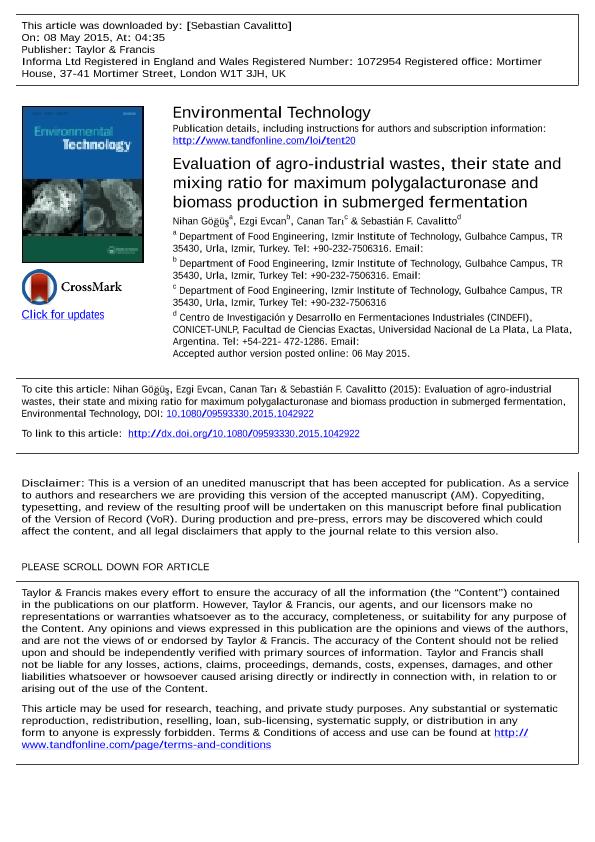Mostrar el registro sencillo del ítem
dc.contributor.author
Göğüş, Nihan
dc.contributor.author
Evcan, Ezgi
dc.contributor.author
Tari, Canan
dc.contributor.author
Cavalitto, Sebastian Fernando

dc.date.available
2017-05-08T18:08:38Z
dc.date.issued
2015
dc.identifier.citation
Göğüş, Nihan; Evcan, Ezgi; Tari, Canan; Cavalitto, Sebastian Fernando; Evaluation of agro-industrial wastes, their state and mixing ratio for maximum polygalacturonase and biomass production in submerged fermentation; Taylor & Francis; Environmental Technology; 36; 20; -1-2015; 2657-2667
dc.identifier.issn
0959-3330
dc.identifier.uri
http://hdl.handle.net/11336/16074
dc.description.abstract
The potential of important agro-industrial wastes, apple pomace (AP) and orange peel (OP) as C sources, was investigated in the maximization of polygalacturonase (PG), an industrially significant enzyme, using an industrially important microorganism Aspergillus sojae. Factors such as various hydrolysis forms of the C sources (hydrolysed-AP, non-hydrolysed-AP, hydrolysed-AP + OP, non-hydrolysed-AP + OP) and N sources (ammonium sulphate and urea), and incubation time (4, 6, and 8 days) were screened. It was observed that maximum PG activity was achieved at a combination of non-hydrolysed-AP + OP and ammonium sulphate with eight days of incubation. For the pre-optimization study, ammonium sulphate concentration and the mixing ratios of AP + OP at different total C concentrations (9, 15, 21 g l−1) were evaluated. The optimum conditions for the maximum PG production (144.96 U ml−1) was found as 21 g l−1 total carbohydrate concentration totally coming from OP at 15 g l−1 ammonium sulphate concentration. On the other hand, 3:1 mixing ratio of OP + AP at 11.50 g l−1 ammonium sulphate concentration also resulted in a considerable PG activity (115.73 U ml−1). These results demonstrated that AP can be evaluated as an additional C source to OP for PG production, which in turn both can be alternative solutions for the elimination of the waste accumulation in the food industry with economical returns.
dc.format
application/pdf
dc.language.iso
eng
dc.publisher
Taylor & Francis

dc.rights
info:eu-repo/semantics/openAccess
dc.rights.uri
https://creativecommons.org/licenses/by-nc-sa/2.5/ar/
dc.subject
Agro-Industrial Waste
dc.subject
Polygalacturonase
dc.subject
Apple Pomace
dc.subject
Orange Peel
dc.subject
Aspergillus Sojae
dc.subject.classification
Bioprocesamiento Tecnológico, Biocatálisis, Fermentación

dc.subject.classification
Biotecnología Industrial

dc.subject.classification
INGENIERÍAS Y TECNOLOGÍAS

dc.title
Evaluation of agro-industrial wastes, their state and mixing ratio for maximum polygalacturonase and biomass production in submerged fermentation
dc.type
info:eu-repo/semantics/article
dc.type
info:ar-repo/semantics/artículo
dc.type
info:eu-repo/semantics/publishedVersion
dc.date.updated
2017-05-05T20:07:04Z
dc.identifier.eissn
1479-487X
dc.journal.volume
36
dc.journal.number
20
dc.journal.pagination
2657-2667
dc.journal.pais
Reino Unido

dc.journal.ciudad
Londres
dc.description.fil
Fil: Göğüş, Nihan. Izmir Institute of Technology; Turquía
dc.description.fil
Fil: Evcan, Ezgi. Izmir Institute of Technology; Turquía
dc.description.fil
Fil: Tari, Canan. Izmir Institute of Technology; Turquía
dc.description.fil
Fil: Cavalitto, Sebastian Fernando. Consejo Nacional de Investigaciones Científicas y Técnicas. Centro Científico Tecnológico Conicet - la Plata. Centro de Investigación y Desarrollo En Fermentaciones Industriales. Universidad Nacional de la Plata. Facultad de Cs.exactas. Centro de Investigación y Desarrollo En Fermentaciones Industriales; Argentina
dc.journal.title
Environmental Technology

dc.relation.alternativeid
info:eu-repo/semantics/altIdentifier/doi/http://dx.doi.org/10.1080/09593330.2015.1042922
dc.relation.alternativeid
info:eu-repo/semantics/altIdentifier/url/http://www.tandfonline.com/doi/full/10.1080/09593330.2015.1042922
Archivos asociados
